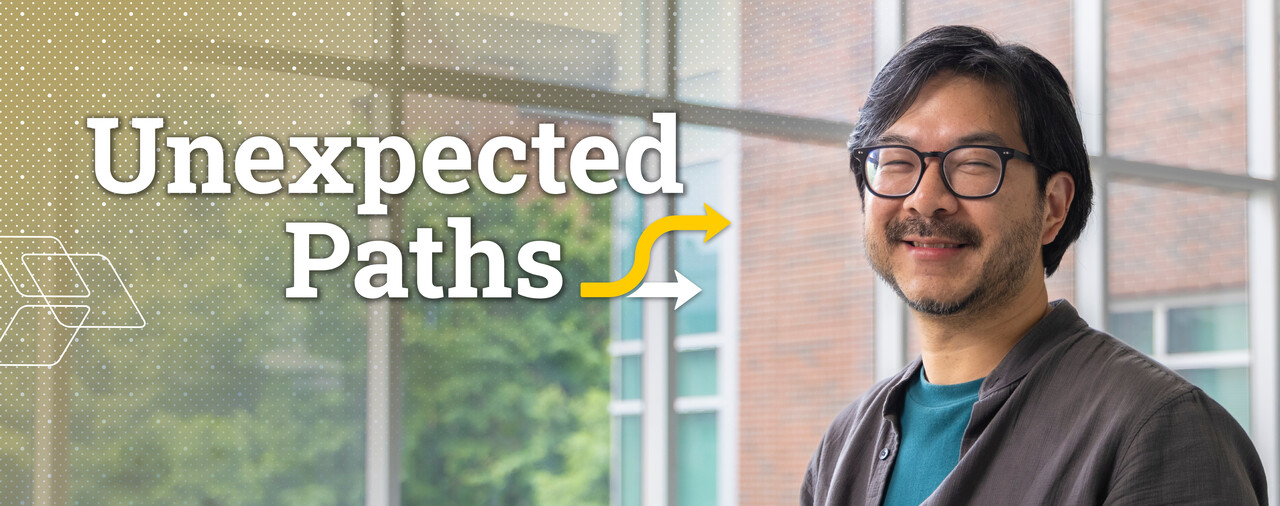From Poetry to Polymers: How the Pursuit of a Creative Path Led to Electrochromic Materials
Eric Shen loves art and science in equal measure — and believes it’s possible for creatives to build STEM careers that foster joy.
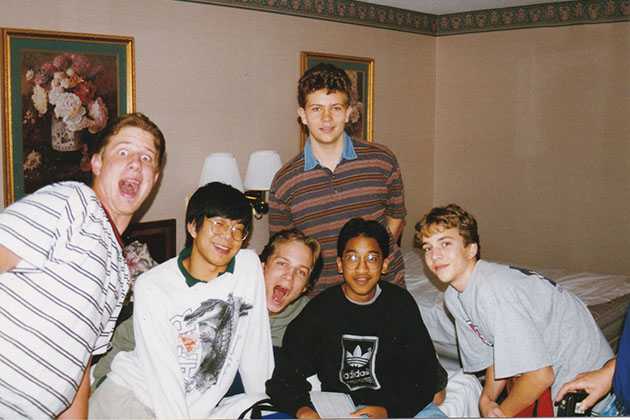
From a young age, Shen (second from left) always valued community and is pictured in Gainesville, Florida with a crew of high school friends.
Eric Shen was raised by two mathematicians but fell in love with the arts.
Growing up in the university town of Gainesville, Florida, Shen was surrounded by academics and STEM professionals. So, he was comfortable with the sciences (even though he still, to this day, does not understand his father’s work with theoretical mathematics). As a high schooler, Shen even worked in chemistry labs during his summer breaks.
When he enrolled at Rice University for his bachelor’s degree, Shen decided to study biology because he was at ease in a lab environment. It didn’t take long for him to realize it wasn’t a good fit.
“I started out in the biological sciences but realized I’m really, really bad at biology,” he said. “And because of this experience, I mistakenly concluded I didn’t like science. I just assumed I wasn’t cut out for it.”
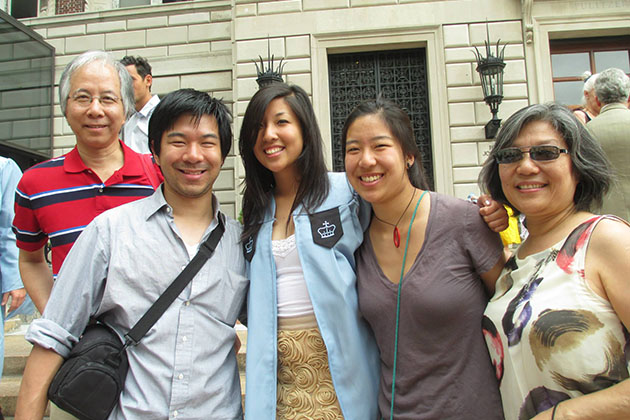
Caption: Shen (second from left) grew up with mathematician parents (pictured far left and far right) who encouraged his love of music and the arts. Returning home for his Ph.D. was also a return home to family.
Amidst this undergraduate crisis of purpose, Shen signed up for a poetry class. He had grown up playing instruments — piano and violin — and participating in orchestra and was always drawn to disciplines that challenged his creativity. He quickly embraced poetry as an exciting new path. This, Shen was sure, was his future.
He completed his bachelor’s degree in English with a poetry focus and even began applying for poetry graduate programs. But something didn’t feel right. Shen realized that he might not be suited for an MFA program. Once again, he felt that none of his paths forward were a fit.
Throughout his time at Rice, Shen kept one foot in the world of sciences, with a job in a chemistry lab. When he realized that MFA programs weren’t going to be his next step, Jim Tour, the principal investigator for Shen’s lab at Rice, offered a suggestion: Move back to Florida and try chemistry.
At that time, John Reynolds was a faculty member in the University of Florida chemistry department, and he encouraged Shen to apply to their graduate program. This return to Gainesville was something Shen was ready to embrace. It was also an opportunity to give science another chance — and this time, it worked. He applied to the program, was accepted, and eventually earned a Ph.D. in polymer chemistry, all while working in Reynolds’ research group.
Twenty-one years later, Shen still works in Reynolds’ lab — but now at Georgia Tech.
Magenta Is the Best Color
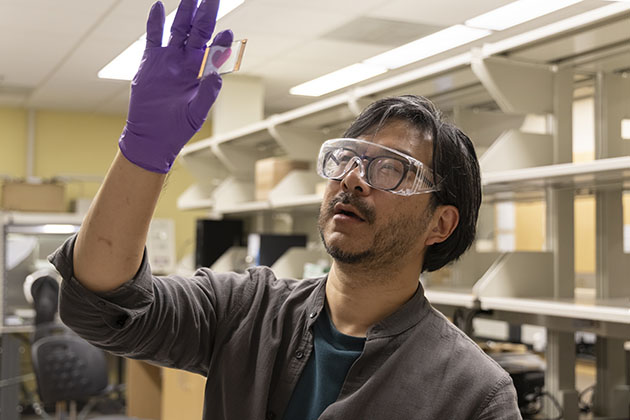
Shen demonstrates his work with electrochromic polymers in his lab at Georgia Tech.
After completing his Ph.D., an opportunity arose in Atlanta: Reynolds was moving his lab to Georgia Tech and wanted Shen to join him.
It was a significant move, but one that paid off. Shen says he can’t imagine having more creative opportunities than he does through Georgia Tech’s College of Sciences.
“There are a lot of creative spirits in our college,” he said. “I have colleagues who are writing memoirs or are part of creative writing circles. Georgia Tech Arts is rapidly expanding, and Atlanta has a vibrant arts scene that I love. There are so many opportunities to think outside the box here, even in our labs, as research scientists and engineers.”
Shen’s daily work as a research engineer is highly technical, but as he notes, it is also quite visual and even playful.
“We make color-changing windows where the color can shift with the push of a button,” he said. “You press the button in your car, an airplane, or building, and it applies a current that changes the color to help block bright light and glare.”
“For me, a job is not just about being at work or not being at work — clocking in and clocking out. It’s also about finding ways to truly enjoy what you do, to keep things fresh and interesting.”
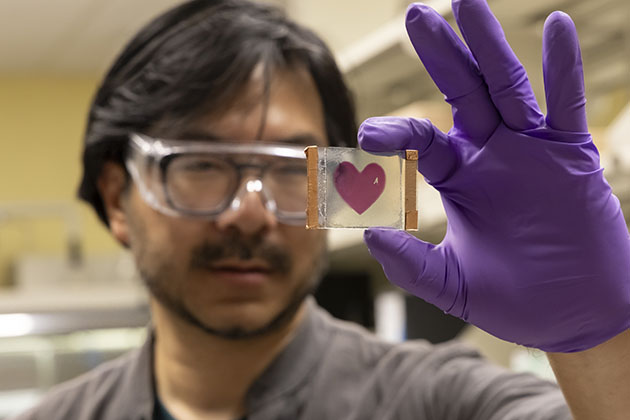
Shen shows off his favorite color-changing magenta tint with a small demonstration of a heart on glass.
Shen and his colleagues' work with electrochromic polymers has many existing and potential applications, including in the aerospace industry (airplane windows), the fashion industry and the military (sunglasses), design companies (commercial building window tints, like those in Midtown Atlanta’s CODA), and even toy companies. Most applications tend to feature dark or near-transparent color palettes, but Shen’s lab also explores vibrant hues: pinks, yellows, oranges, blues, and greens.
“I have a soft spot for our magenta tint,” said Shen. “I had a stuffed animal this color as a kid, and it’s spot-on the same color. It’s so nostalgic for me. We can apply voltage to that bright color, and it’ll become a clear, colorless film. I love it.”
Shen believes work should be both meaningful and fun, a balance he says is essential to the creative spirit.
“I get to have fun at my job working with these tints while also making something that has real-world impact,” he said. “For example, when our polymers are applied to the windows of buildings, they can actually change how much heat gets in. If you regulate the heat this way, there can be substantial energy savings.”
Community Fuels a Creative Life
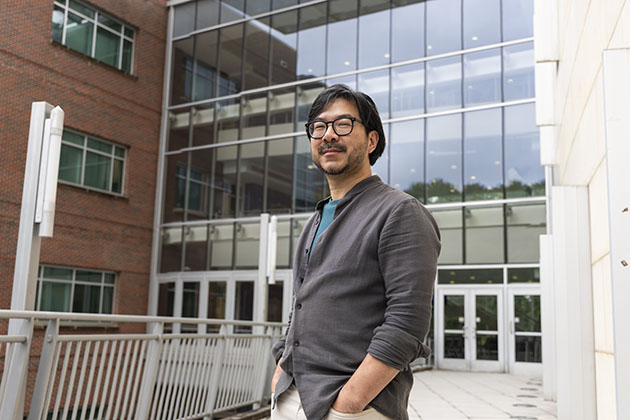
Shen is pictured outside the Molecular Science and Engineering Building on Georgia Tech’s Atlanta campus.
These days, the lab isn’t the only place on campus where Shen can be found — he’s also in the classroom, teaching.
“I teach organic chemistry for engineers and occasionally general chemistry as well,” he said. “That’s one of the nice things about the research faculty role; it’s quite fluid and can fill so many different needs across campus. Some of us are completely in the lab, which is perfect, and some of us like to mix it up because we enjoy teaching. It’s quite malleable. It keeps my day-to-day and month-to-month lively.”
On top of his research and teaching, Shen started an alumni mentorship program that pairs current graduate students in the School of Chemistry and Biochemistry with successful alumni. He credits his career to the guidance of a mentor (Reynolds) at a time when he wasn’t sure what path to take. He hopes to be that person for others — to create paths and relationships for Georgia Tech students as they look to their own futures.
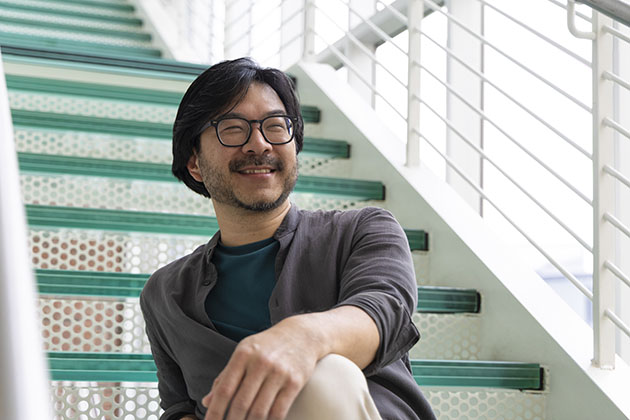
Shen, who has been a beloved member of the research faculty community at Georgia Tech for 13 years, was greeted by enthusiastic colleagues and students throughout his photoshoot.
Shen also loves connecting with people and sees building community as a creative necessity.
“Sometimes I’ll camp out and set up my computer in the atrium of our building because I just enjoy talking to people as they pass by — hearing about how they’re doing and that kind of thing,” he said. “It’s super important to me.”
Shen believes mentorship and community fuel a happy, lasting career. He finds joy in developing novel applications for his favorite tint and guiding graduate students as they navigate their burgeoning careers. He has even served as the faculty advisor of the Georgia Tech Figure Skating Club.
“For me, a job is not just about being at work or not being at work — clocking in and clocking out,” he said. “It’s also about finding ways to truly enjoy what you do, to keep things fresh and interesting.”
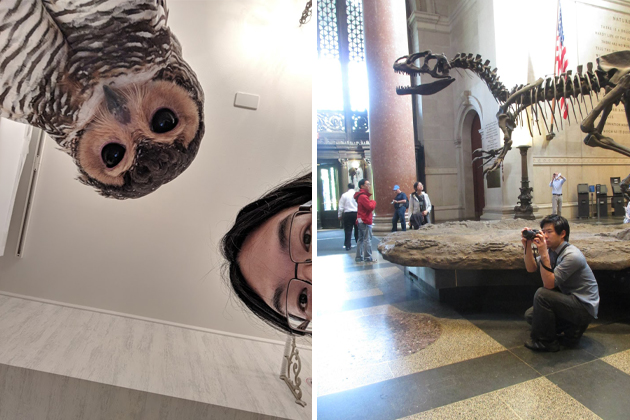
Shen is always looking to learn and share new experiences, like visiting an owl café in Japan (left) or documenting dinosaurs at the American Museum of Natural History (right).
From orchestra to biology to poetry to chemistry, Shen’s career offers a lesson in embracing unexpected opportunity. In 2012, he was even able to move to Germany for a year to work for BASF, one of the world’s largest chemical producers.
“Decisions are never as permanent as they seem in the moment,” he noted, with a smile and shrug. “In our college, our philosophy is to do more and explore our full potential. And doing that can be fun.”
No matter the setting, Shen finds ways to pursue both fun and meaning. Whether he is reading poetry — his current favorite is Poet Laureate Ada Limón, a past guest of Poetry@Tech — developing a vibrant new tint, teaching, or building a catio (his summer project to construct an enclosed patio for his cats), he relishes the creative, scientific life he has built in Atlanta.

Writer and Media Contact: Brittany Aiello, Faculty Communications Program Manager | brittany.aiello@gatech.edu
Video: Christopher McKenney, Video Producer, Research Creative Services
Photos: Christopher McKenney and courtesy of Eric Shen
Series Design: Daniel Mableton, Senior Graphic Designer, Research Creative Services
About the School of Chemistry & Biochemistry
The School of Chemistry & Biochemistry in Georgia Tech’s College of Sciences is committed to excellence in research, education, and innovation. Building on its collaborative culture and interdisciplinary programs, the school prepares future leaders to address 21st-century scientific and technological challenges. It provides rigorous educational programs that integrate research and global issues, advances knowledge through cutting-edge research, supports economic development by training a diverse workforce, fosters an inclusive community, and promotes a broader understanding of science among stakeholders and the public.
Learn More
To explore careers in research, visit the Georgia Tech Careers website. To learn more about life as a research scientist at Georgia Tech, visit our guide to Research Resources or explore the Prospective Faculty hub on the Office of the Vice Provost for Faculty website.

